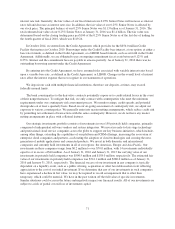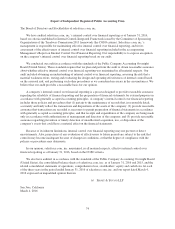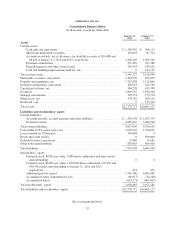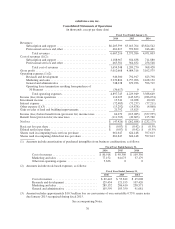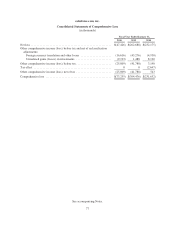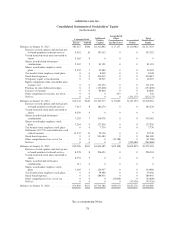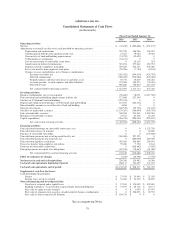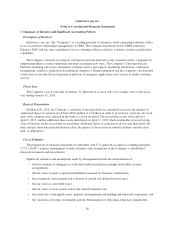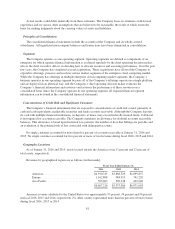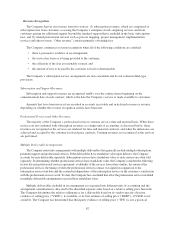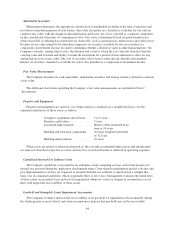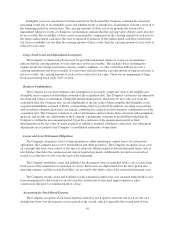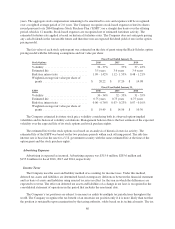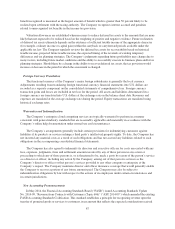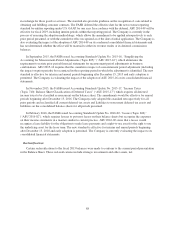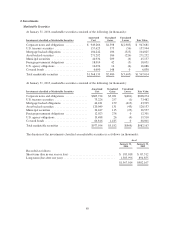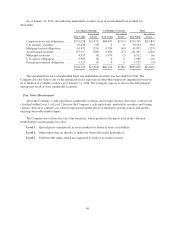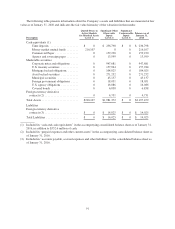Salesforce.com 2016 Annual Report Download - page 88
Download and view the complete annual report
Please find page 88 of the 2016 Salesforce.com annual report below. You can navigate through the pages in the report by either clicking on the pages listed below, or by using the keyword search tool below to find specific information within the annual report.
Actual results could differ materially from those estimates. The Company bases its estimates on historical
experience and on various other assumptions that are believed to be reasonable, the result of which forms the
basis for making judgments about the carrying values of assets and liabilities.
Principles of Consolidation
The consolidated financial statements include the accounts of the Company and its wholly-owned
subsidiaries. All significant intercompany balances and transactions have been eliminated in consolidation.
Segments
The Company operates as one operating segment. Operating segments are defined as components of an
enterprise for which separate financial information is evaluated regularly by the chief operating decision maker,
who is the chief executive officer, in deciding how to allocate resources and assessing performance. Over the past
few years, the Company has completed several acquisitions. These acquisitions have allowed the Company to
expand its offerings, presence and reach in various market segments of the enterprise cloud computing market.
While the Company has offerings in multiple enterprise cloud computing market segments, the Company’s
business operates in one operating segment because all of the Company’s offerings operate on a single platform
and are deployed in an identical way, and the Company’s chief operating decision maker evaluates the
Company’s financial information and resources and assesses the performance of these resources on a
consolidated basis. Since the Company operates in one operating segment, all required financial segment
information can be found in the consolidated financial statements.
Concentrations of Credit Risk and Significant Customers
The Company’s financial instruments that are exposed to concentrations of credit risk consist primarily of
cash and cash equivalents, marketable securities and trade accounts receivable. Although the Company deposits
its cash with multiple financial institutions, its deposits, at times, may exceed federally insured limits. Collateral
is not required for accounts receivable. The Company maintains an allowance for doubtful accounts receivable
balances. This allowance is based upon historical loss patterns, the number of days that billings are past due and
an evaluation of the potential risk of loss associated with delinquent accounts.
No single customer accounted for more than five percent of accounts receivable at January 31, 2016 and
2015. No single customer accounted for five percent or more of total revenue during fiscal 2016, 2015 and 2014.
Geographic Locations
As of January 31, 2016 and 2015, assets located outside the Americas were 11 percent and 12 percent of
total assets, respectively.
Revenues by geographical region are as follows (in thousands):
Fiscal Year Ended January 31,
2016 2015 2014
Americas ............................... $4,910,745 $3,868,329 $2,899,837
Europe ................................. 1,162,808 984,919 741,220
Asia Pacific ............................. 593,663 520,338 429,946
$6,667,216 $5,373,586 $4,071,003
Americas revenue attributed to the United States was approximately 95 percent, 94 percent and 96 percent
in fiscal 2016, 2015 and 2014, respectively. No other country represented more than ten percent of total revenue
during fiscal 2016, 2015 or 2014.
81


